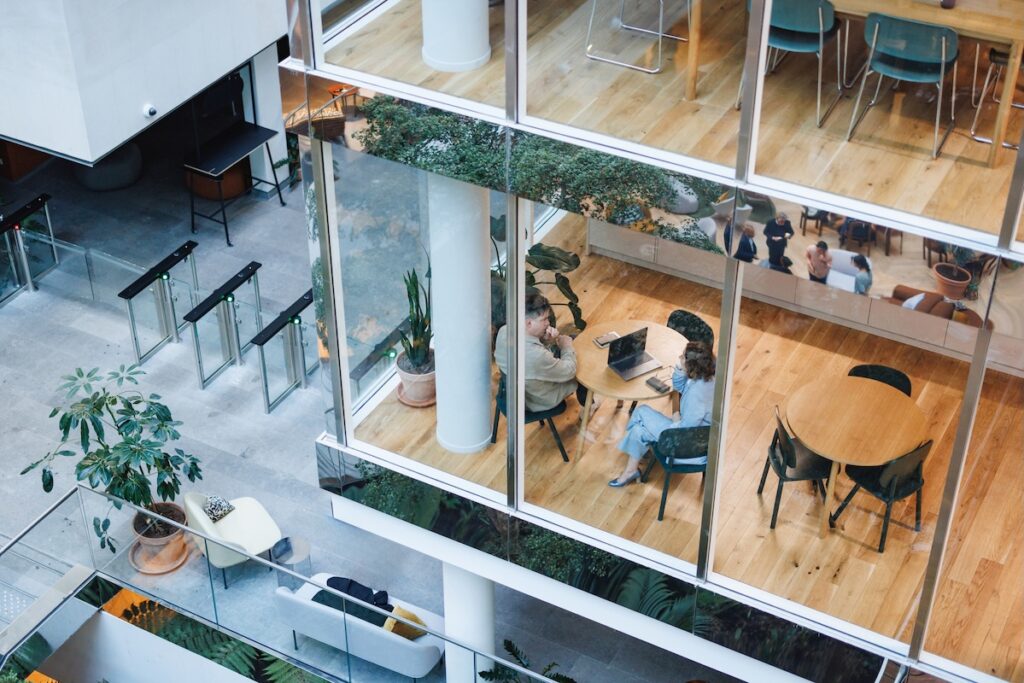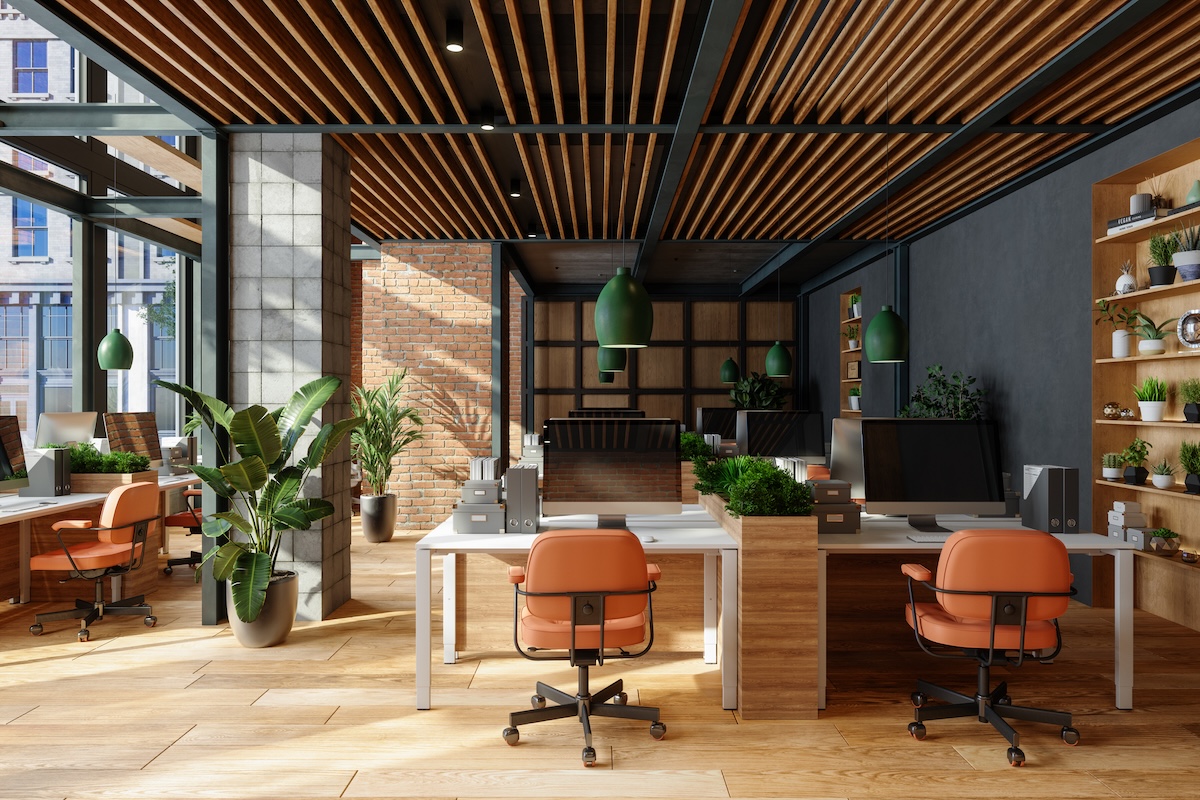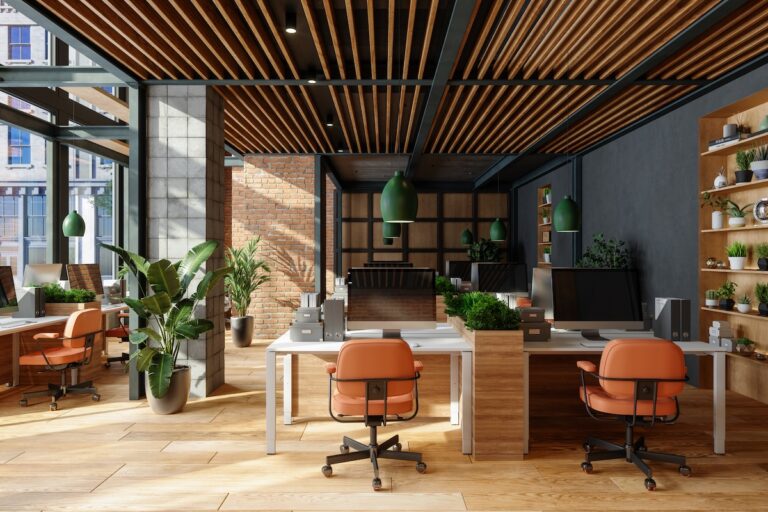You’re stuck in the last century (or as the kids say “late 1900s”) if your employees are still trapped within 3 foam walls for 8 hours a day. The design for office interiors has seen major shifts over the last few decades. From constricting grey cubes to suddenly wide open desks with zero privacy, the people working in them just can’t seem to get a break. So we’re here to change that.
Here are the key office design trends that aim to balance aesthetics and functionality, creating spaces for maximum productivity and genuine employee wellbeing.
Key Office Design Trends in 2025
Trend 1: Immersive Environments
Workspaces shouldn’t just look great in company photo ops, they should feel great to actually be in. Since people spend most of their waking hours here, these offices should be pleasant to all our senses — sight, sound, smell, touch, and taste (free snacks are always a good idea, people get easily cranky when hungry).
Sample applications:
- Use natural textures like wood, cork, and stone for a visual and tactile reset, calming the senses after hours of screen time.
- Introduce biophilic elements (plants, water features, and daylight) to boost mood, creativity, and a sense of connection.
- Choose sustainable office flooring made from eco-conscious materials. Beyond aesthetics, it reinforces your company’s commitment to the planet and gives employees something to feel proud of every time they step through the door.
Trend 2: People-Centric Design
Don’t you just love it when you feel instantly at home in a place that’s not actually your home? Or what about a place that instantly sets you in “the zone”? Now, imagine having both. By building inclusive workspaces that actually cater to people’s real, diverse needs, you make office days worth the commute.
Sample applications:
- Implement flexible seating arrangements so teams can work where they feel most creative.
- Design ergonomic zones with adjustable desks, supportive chairs, and posture-friendly tools that reduce physical strain and boost long-term comfort — your employees (and your back) will thank you for it.
- Bonus points if you create quiet areas for those who need calm and flexible rooms that work just as well for group huddles or solo thinking time.
Trend 3: Sustainability and Adaptive Reuse
Sustainability isn’t just a buzzword, it’s a real point of consideration of today’s brightest minds. So retrofitting old buildings and using eco-friendly materials like recycled floor options aren’t just for PR reasons, they help our planet and actually attract the best talents that improve your bottom line. These design choices speak volumes to both clients and future hires, showing that your company walks the talk.
Sample applications:
- Change your bulbs to energy-efficient lighting — one of the quickest ways to cut long-term costs and reduce your environmental footprint.
- Install reclaimed wood flooring to bring warmth and character into your space while keeping materials out of landfills.
- Up the vibe with recycled modular furniture that’s stylish, functional, and adaptable to future needs.
Trend 4: Tech-Integrated Spaces
Not too cold, not too hot. Not too bright, just the right amount of light. It’s a Goldilocks situation every work day — made possible by smart technology and AI that adapts in real time. These innovations are not just changing how we work; they’re actively shaping how spaces cater to us. Think tech with a purpose. They make workspaces more intuitive, efficient, and comfortable.
Sample applications:
- Use AI to achieve the perfect lighting and temperature based on occupancy, time of day, or even individual preferences.
- Integrate sensor-driven systems that adjust airflow, reduce energy waste, and provide data-backed insights to optimize layout and usage.
Trend 5: Biophilic and Wellness-Oriented Design
Nature is healing, especially when work gets overwhelming. Give your employees more than just a place to work; give them space to breathe, reset, and feel grounded. When your office interior design prioritizes wellness, you’ll get pockets of peace that improve satisfaction, reduce stress, and support long-term productivity.
Sample applications:
- Build rooftop gardens, vertical green walls, and indoor water features to reconnect people with nature even in the middle of a busy city.
- Let in more natural light.
- Add quiet nooks surrounded by plants.
It’s more than aesthetics — it’s about creating a workplace that helps people feel good so they can do good.

Why you need to balance aesthetics and functionality
Offices have gone beyond “just a place to work.” They now reflect a company’s brand, inspire employees, and promote overall well-being. These spaces are seen as avenues for growth — personal, professional, and cultural. So don’t box people in, give them room to flourish.
A poorly designed office (even those that look stunning in photos) can slow your team down. It makes everything feel like a drag, collaboration like jumping through hoops, and employee satisfaction a pipedream.
So don’t just design visually. Design intentionally. Create a functional space that helps your people — and your business — truly thrive.
Key considerations in applying office design trends
A Unified Design Philosophy
Every element — from flooring to furnishings, lighting to layout — should work together with purpose. A cohesive approach ensures that aesthetics never get in the way of usability, and functionality never comes at the cost of beauty.
Zoning for Balance
Use visual and material cues (like color, flooring, or ceiling height) to define zones for focus, collaboration, and relaxation. Acoustic treatments, lighting changes, and strategic furniture placement can subtly guide behavior without building walls.
Employee-Centric Design
Design with your people in mind. Incorporate ergonomic furniture, natural light, and accessible layouts. Consider neurodiversity, mobility, and cultural needs. True inclusivity goes beyond checklists — it’s about creating a space where everyone feels they belong.
Conclusion
Function and form can beautifully coexist in your workspace. When your design for office interiors addresses real human needs, it doesn’t just look good, it actually works. Inspire employees, boost productivity, and adapt to future demands with functionally aesthetic design.
Not sure where to start?
Explore Dynamic Interiors’ portfolio or book a consultation to transform your workplace into a space that’s both practical and pleasing to all our senses.



